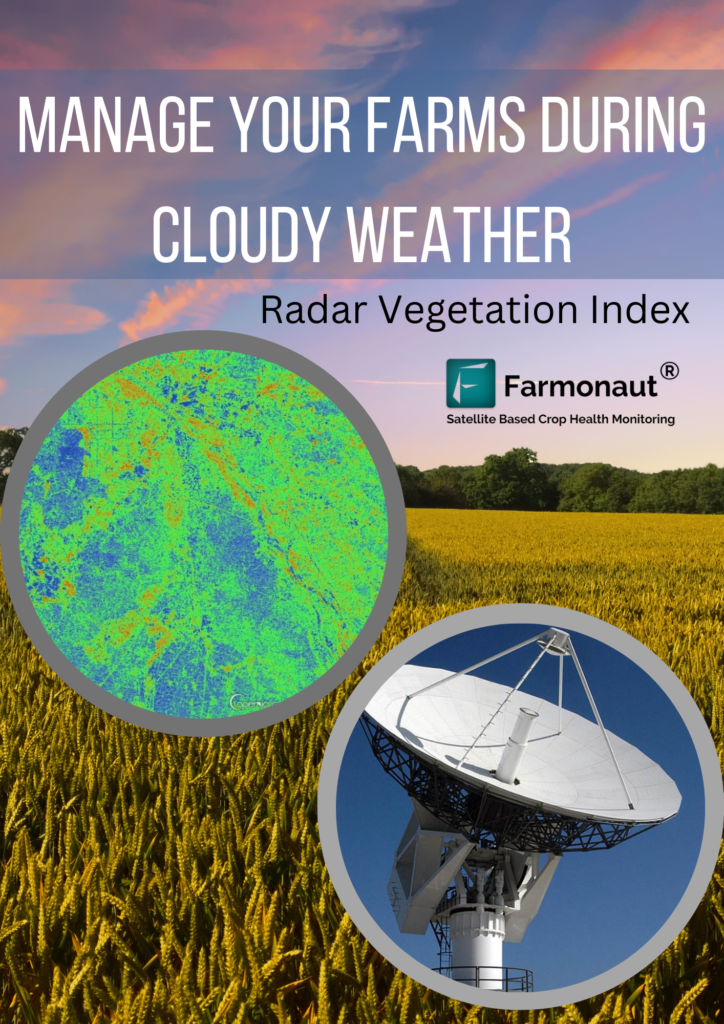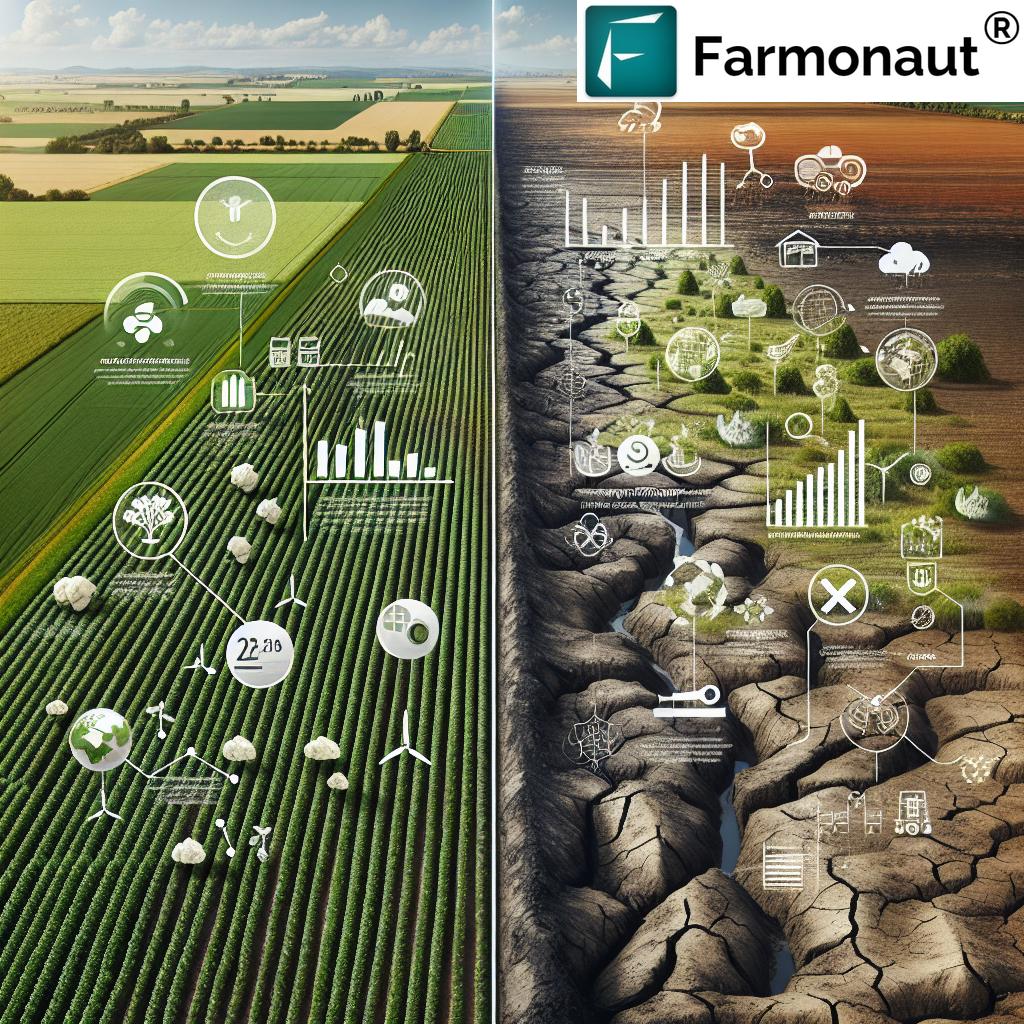Table of Contents
- Introduction: Understanding La Niña and its Impact on Agriculture
- La Niña Effects on Agriculture: Key Impacts
- La Niña and Forestry: Challenges and Growth
- Comparison Table: La Niña Effects vs. Agricultural Resilience Strategies
- 7 Resilience Tips for Farmers: Successfully Mitigating La Niña Challenges
- How Farmonaut Empowers Farmers and Agribusinesses
- Frequently Asked Questions (FAQ) on La Niña and Agriculture
- Conclusion: Building Climate Resilience for the Future
“La Niña events can reduce global maize yields by up to 4%, impacting food security worldwide.”
La Niña Impact on Agriculture: 7 Resilience Tips
La Niña effects on agriculture are profound and multifaceted, influencing crop yields, forest dynamics, weather, and ecosystem productivity across the world. As a climatic phenomenon defined by cooler-than-average sea surface temperatures in the central and eastern Pacific Ocean, La Niña significantly alters global weather patterns. These shifts bring about increased rainfall in some regions and severe drought in others—posing both challenges and opportunities for agriculture and forestry.
The impact of La Niña on crop yields can range from improved harvests in places like southern Africa to catastrophic losses in South America or the United States due to flooding or drought. This makes understanding the effects and preparing flexible drought mitigation strategies and resilience practices crucial for boosting productivity and ensuring food security.
La Niña Effects on Agriculture: Key Impacts
At its core, La Niña’s strength lies not in one effect, but in the vast tapestry of weather patterns influencing farming—from torrential downpours and flooding to prolonged drought and temperature swings. To mitigate the adverse effects and capitalize on potential benefits, let’s explore the main ways La Niña disrupts (or aids) agricultural systems worldwide:
1. Increased Rainfall and Flooding Risks
- Regions affected: Australia, Southeast Asia, and parts of South America often experience up to 40% more rainfall during La Niña events (Source).
- Impacts: This increased rainfall can result in waterlogging, hypoxia (soil oxygen deficiency), topsoil erosion, and heightened fungal disease risks. Flooding also strips away essential nutrients and reduces land productivity.
- Farm Management Challenge: Fields may become impassable, machinery damaged, and planting delayed; crop yields suffer.
2. Drought, Decreased Soil Moisture, and Heat Stress
- Regions affected: Midwestern United States, South America, the Horn of Africa.
- Impacts: Extended drought diminishes soil moisture, impairs photosynthesis, and weakens plant and root structures. Fields become vulnerable to pests, diseases, and heat stress.
- Productivity Loss: Reduced water hampers crop development, causes leaf wilting, and may result in yield losses of 10-30%.
Clearly, the climatic phenomenon of La Niña significantly influences agriculture by altering water availability, flooding patterns, and plant disease cycles across different regions. Resilient crop varieties for extreme weather and targeted soil conservation practices for farmers are essential for adapting to these disruptions.
3. Crop Yield Variations: Regional Winners and Losers
- Yield gains: Southern Africa’s maize production increased by 11% during La Niña years due to more favorable rainfall and moderate temperatures (Source).
- Yield losses: Crop yields in South America or the United States may fall, depending on the timing and severity of drought or excess rainfall.
- Complex interplay: The impact of La Niña on crop yields depends on the intricate dance between precipitation, temperature, and timing.
Ultimately, weather patterns influencing farming are inconsistent across events and years, challenging us to plan for uncertainty.
“During La Niña years, some regions experience up to 40% more rainfall, increasing flood risks for farmers.”
4. Changing Patterns of Pests, Diseases, and Crop Stress
- Fungal & Bacterial Diseases: Moist, oxygen-deficient soils and warmer weather boost fungal disease risk and enable the spread of crop-affecting bacteria.
- Pest Surges: Plants under stress (especially drought) have weaker defenses, allowing insects and pathogens to thrive, especially in parts of Africa, Asia, and South America.
- Adaptability: Pest and disease management in agriculture must be agile and region-specific during La Niña phases.
5. Soil Health, Nutrient Loss, and Erosion
- Waterlogging: Fields may remain saturated for weeks; anaerobic soils favor specific plant pathogens and reduce crop vigor.
- Topsoil Erosion: Flooding or heavy rainfall strips soils of organic matter and nutrients vital for growth.
- Impact: Eroded or compacted soils are less fertile, more difficult to cultivate, and have reduced water retention.
La Niña and Forestry: Challenges and Growth
The climate change challenges for forestry during La Niña events are underappreciated:
- Increased Rainfall can benefit forest growth and biomass accumulation, especially in Australia, Southeast Asia, and tropical regions.
- Drought stress in afflicted areas of the Horn of Africa, the United States, or South America often leads to stunted tree growth, heightened pest susceptibility, and higher tree mortality rates.
- As with crops, forestry management hinges on anticipating weather patterns and employing both preventative and active mitigation strategies.
Our understanding of La Niña’s effects in forestry underscores the need for carbon footprinting tools (to monitor forest health/sustainability) and blockchain-based traceability (for better resource management and timber origin verification).
Comparison Table: La Niña Effects vs. Agricultural Resilience Strategies
A quick, practical overview of the main impacts and their top resilience responses for farmers, linking directly to actionable solutions.
| La Niña Impact | Estimated Effect on Yield (%) | Recommended Resilience Practice |
|---|---|---|
| Increased Rainfall | -15% to -30% | Improve field drainage and select flood-tolerant seed varieties |
| Flooding/Washing of Topsoil | -20% to -40% | Establish soil conservation measures (cover cropping, no-till) |
| Drought/Low Soil Moisture | -10% to -30% | Implement efficient irrigation, water harvesting, and select drought-resilient crops |
| Late Onset Monsoon | -10% to -15% | Diversify crop varieties and stagger planting schedules |
| Increased Disease and Pest Pressure | -5% to -20% | Enhanced pest/disease scouting and integrated management |
| Nutrient Loss via Runoff | -10% to -15% | Apply organic matter and monitor nutrition via satellite/advisory tools |
7 Resilience Tips for Farmers: Successfully Mitigating La Niña Challenges
Based on scientific research and best global practices, here are 7 powerful resilience strategies to boost agricultural productivity during La Niña. These combine technology, climate-smart management, and adaptive planning:
1. Adopt Enhanced Seed Varieties and Resilient Crops
- What & Why: Opt for flood, drought, and stress-tolerant hybrids—these resist both infection and environmental extremes.
- How: Work with local agronomists to access certified and regionally adapted seeds.
- Benefit: Stability in yields despite erratic weather patterns.
- More on enhancing productivity through precision: Try Farmonaut’s satellite-based farm monitoring app for early detection of crop stress and optimal input timings!
2. Implement Soil Conservation Practices for Farmers
- Key Actions: Practice no-till farming, cover cropping, retaining crop residue, and incorporate agroforestry to guard against erosion.
- Result: Improved soil water retention, root development, less nutrient loss.
- Tip: Regular satellite-based monitoring of soil health metrics can be accessed via Farmonaut’s Jeevn AI Advisory System, directly from our web and mobile apps.
3. Efficient Water Management and Drought Mitigation Strategies
- Techniques: Drip irrigation, rainwater harvesting, and mulching to conserve water and regulate soil moisture.
- Productivity Boost: Reduces drought impact, ensures crops get the moisture needed for proper development.
- Farmonaut API: Integrate real-time precipitation and soil moisture data into your operations. Access: Farmonaut Satellite & Weather API | Developer Docs
4. Crop Diversification and Rotation
- How it helps: Growing multiple crops with different water/nutrient needs (“polyculture systems”) lowers system-wide risk during extreme La Niña weather events.
- Rotation: Alternate deep and shallow-rooted crops each season to maintain soil health and break disease cycles.
- Outcome: More stable annual yields and reduced pest outbreaks.
5. Tailor Pest and Disease Management in Agriculture
- Why essential: Increased rainfall and higher temperatures favor pests/fungi. La Niña can trigger sudden outbreaks, especially as plant stress lowers resistance.
- Action Plan: Scout fields more frequently, use local disease prediction models, and encourage integrated pest management (IPM).
- Leverage tech: Use AI-based crop health alerts on Farmonaut for early detection of infestations.
6. Leverage Real-Time Weather and Resource Management Tools
- Overview: Monitor weather patterns influencing farming and anticipate extreme events through reliable forecasts.
- How: Use Farmonaut’s Jeevn AI Advisory and large-scale farm management tools for multi-farm analytics, or integrate satellite-based weather intelligence via API for farm-level automation.
- Application: Plan crop cycles, application timings, and logistic operations to mitigate flood/drought risk.
7. Build Resilient Supply Chains: Blockchain Traceability & Crop Insurance
- Why: Weather volatility increases the risk of harvest losses, fraud, and supply chain disruptions.
-
How to adapt:
- Blockchain-Based Traceability: Enhance transparency and safety from farm to table in food and fiber supply chains.
- Satellite-Driven Crop Loan & Insurance Verification: Streamline access to financing and insurance with accurate, tamper-proof verification of farm losses or health.
Bonus: Embracing Technology for Long-Term Climate Resilience
- Real-time monitoring of plant health, soil moisture, and weather is now affordable and accessible for all scales, from small farms in Africa to expansive agribusinesses in South America.
- Use carbon footprint tracking (details) to promote sustainability and compliance, especially important for forestry-impacted operations during extreme La Niña years.
- Fleet and Resource Management: Large farms or cooperatives can reduce cost and loss during erratic weather using Farmonaut’s digital fleet tracking solutions.
Farmonaut Subscriptions: Affordable Precision Farming for All
Unlock advanced satellite monitoring, AI advisories, and resource optimization—customize your plan for single farms, group cooperatives, or enterprise operations.
How Farmonaut Empowers Farmers and Agribusinesses
At Farmonaut, our mission is to democratize precision agriculture. By blending multispectral satellite imagery, artificial intelligence, blockchain, and advanced analytics, we support farmers, agribusinesses, and governments in mitigating the adverse effects of La Niña and other climatic phenomena:
- Satellite-Based Crop Health Monitoring: Access real-time NDVI, soil moisture, and crop stress maps for smarter irrigation, nutrient management, and timely pest/disease mitigation.
- AI-Based Jeevn Advisory System: Receive personalized, actionable advice—right when you need it—to boost resilience and improve agricultural productivity during La Niña.
- Blockchain-Based Traceability: Maintain transparent, tamper-proof supply chains—especially vital when volatile weather disrupts traditional verification.
- Fleet and Resource Management: Coordinate logistics efficiently even during flood or drought conditions—minimizing downtime and maximizing harvest value.
- Carbon Footprint Tracking: Monitor and reduce your environmental impact and increase the sustainability of both agriculture and forestry operations. Read more about our carbon footprinting solutions.
- API & Integration: Seamlessly connect satellite and weather data with your existing digital workflows. Access our API or explore detailed developer docs for custom solutions.
- All-in-One Platform: Get started from desktop or mobile with our Farmonaut app—available for Android, iOS, and the web.
Frequently Asked Questions (FAQ) on La Niña and Agriculture
What is La Niña and how does it form?
La Niña is a climatic phenomenon characterized by cooler-than-average sea surface temperatures in the central and eastern Pacific Ocean. It typically arises every 2–7 years and lasts for 9–12 months. La Niña significantly influences global weather patterns, causing different effects regionally—ranging from increased rainfall and flooding to severe drought.
How do La Niña effects on agriculture vary by region?
La Niña’s agricultural impact varies: In Australia, Southeast Asia, and parts of South America, farmers may experience torrential rainfall and flood risks. The Midwestern United States and the Horn of Africa may instead face drought and soil moisture depletion, making resilience strategies and local adaptation crucial.
What are the main risks to crops and forests during La Niña?
Key threats include waterlogging, soil erosion, hypoxia, topsoil/nutrient loss, pest and disease surges, and yield volatility. Forests may see stunted growth, pest infestations, and higher mortality in drought-hit zones, but may benefit from rainfall in others.
How can farmers monitor La Niña risks and make timely decisions?
By leveraging satellite imagery, real-time weather data, and AI-driven field advisories (all available through the Farmonaut app), farmers can anticipate extreme weather patterns, detect crop stress early, and adapt field management rapidly.
Are there technologies to help secure farm income and supply chains during La Niña?
Absolutely! Blockchain-based supply chain tracking and satellite-powered crop insurance verification (from Farmonaut) minimize risk, ensure transparency, and speed up access to disaster relief funds or market entry.
Conclusion: Building Climate Resilience for the Future
As La Niña continues to shape global weather patterns and disrupt agriculture and forestry, our path forward must fuse advanced technology, climate-adapted practices, and data-driven planning. Whether you are farming in South America, the United States, Australia, Southeast Asia, or Africa, your success depends on proactive adaptation.
Farmonaut empowers you with affordable, precise, and actionable insights, enabling you to mitigate adverse impacts, seize opportunities, and sustain productivity throughout La Niña events and beyond. By embracing enhanced seeds, conservation management, smart irrigation, blockchain traceability, and satellite monitoring, we can together fortify our farms and forests against an uncertain climate future.
Ready to take control? Explore the Farmonaut platform now—and be at the forefront of resilient, sustainable agriculture.
















